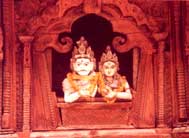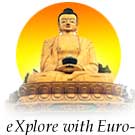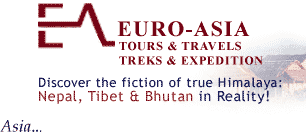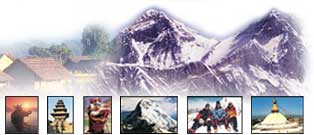Nepal
Information
 Nepal's
history is closely related to its geographical location, separating
the fertile plains of India from the desert-like plateau of
Tibet. Its position between Indian and China meant the country
was able at times to play the role of intermediary - a canny
trader between two great powers - while at other times it
faced the threat of invasion. Internally, its history was
just as dynamic, with city-states in the hills vying with
each other for power until one powerful king, Prithivi Narayan
Shah, overran them all. That history is very visible today
with the three great towns of the Kathmandu valley - Kathmandu,
Patan and Bhaktapur - still bearing witness to their days
as fiercely competitive mediaeval mini-kingdoms. Indeed, in
Nepal it's often possible to suspend belief and mentally roll
the clock right back to the mediaeval era. Nepal's
history is closely related to its geographical location, separating
the fertile plains of India from the desert-like plateau of
Tibet. Its position between Indian and China meant the country
was able at times to play the role of intermediary - a canny
trader between two great powers - while at other times it
faced the threat of invasion. Internally, its history was
just as dynamic, with city-states in the hills vying with
each other for power until one powerful king, Prithivi Narayan
Shah, overran them all. That history is very visible today
with the three great towns of the Kathmandu valley - Kathmandu,
Patan and Bhaktapur - still bearing witness to their days
as fiercely competitive mediaeval mini-kingdoms. Indeed, in
Nepal it's often possible to suspend belief and mentally roll
the clock right back to the mediaeval era.
Behind the old temples and places of the Kathmandu
Valley, above and beyond the hills that surrounding the valley,
another kingdom' rises skyward. The abode of snows' which
is what Himalaya means in Sanskrit, is a natural kingdom'
and a magnet to mountaineers from all above the world. You
don't have to be Sherpa or Hillary in order for you to get
in amongst these great mountains. With a touch of enterprises
and a modicum of fitness most travelers can walk the trails
that lead into the road less heights of the Himalaya. In Nepal
one trek is rarely enough, and many visitors soon find themselves
planning to return. Fascinating old town, magnificent temples
and great walking are not all Nepal has to offer. Many visitors
come to Nepal expecting to find these things but also discover
how outstanding friendly the Nepalese are.
Geography
 In
two of the three dimensions, length and breadth, Nepal is
just another small country. In the third, height, it's number
one in the world. Nepal starches from north-west to south-east
about 800 km and varies in width from around 90 km to 230
km. This gives it a total area of just 147,181 sq. km according
to the official figures. In
two of the three dimensions, length and breadth, Nepal is
just another small country. In the third, height, it's number
one in the world. Nepal starches from north-west to south-east
about 800 km and varies in width from around 90 km to 230
km. This gives it a total area of just 147,181 sq. km according
to the official figures.
Within that small area, however, is the greatest
range of altitude to be seen on this earth - starting with
the Terai, only 100m or so above sea level, and finishing
at the top of Mt. Everest (8848m), the highest point on earth.
Often a visitor's overriding goal is to see
the mountains, especially Everest and Annapurna. However,
to exclude the people, flowers, birds and wildlife from the
experience is to miss the essence of the country regions,
or natural zones: the plains in the south, four mountain ranges,
and the valley lying between them. The lowlands with their
fertile soils, and the southern slopes of the mountains with
sunny exposures, allow for cultivation and are the main inhabited
regions.
Climate
 Nepal
has four distinct seasons. Spring from March to May, is warm
with rain showers. Summer, from June to August, is the monsoon
season when the hills turn lush and green. Autumn, from September
to November, is cool with clear skies and is the most popular
season for trekking. In winter, from December to February,
it is cold at night, with fog in the early morning. Nepal
has four distinct seasons. Spring from March to May, is warm
with rain showers. Summer, from June to August, is the monsoon
season when the hills turn lush and green. Autumn, from September
to November, is cool with clear skies and is the most popular
season for trekking. In winter, from December to February,
it is cold at night, with fog in the early morning.
Because Nepal is quite far south in Latitude
(same as Miami), the weather is warmer and winter is much
milder at lower elevations. The monsoon is determined by the
Bay of Bengal. It is hot during the monsoon with rain almost
everyday. During this season, trekking in most of Nepal is
difficult and uncomfortable, the trails being muddy and infested
with leeches. It usually does not rain for more that one or
two days during the entire autumn and the winter season. In
the winter, the mountains are covered with snow including
some high hills. Mt. Everest itself is a huge black rock during
the trekking season, which becomes snow-covered only during
the winter.
Population
 Nepal's
population currently stands at around 23 million (1998 estimate).
Every year population increases by nearly 600,000. The largest
city is Kathmandu, the capital, with more than 700,000 people.
In the mountains the rate of increase is lower than in Terai,
but this is because many people are migrating in search of
land and work. Despite extremely high rates of infant morality,
the life expectancy is only a horrifying 54 years, the overall
annual rate of population increase is a rapid 2.6%. Family
planning is primary importance, but most people continue to
regard children as a blessing. A child is seen as a vital
and fulfilling part of the parents' life, an extra worker
and someone to care for them in old age, not just an extra
stomach. Women have an average of more than four children
each. Nepal's
population currently stands at around 23 million (1998 estimate).
Every year population increases by nearly 600,000. The largest
city is Kathmandu, the capital, with more than 700,000 people.
In the mountains the rate of increase is lower than in Terai,
but this is because many people are migrating in search of
land and work. Despite extremely high rates of infant morality,
the life expectancy is only a horrifying 54 years, the overall
annual rate of population increase is a rapid 2.6%. Family
planning is primary importance, but most people continue to
regard children as a blessing. A child is seen as a vital
and fulfilling part of the parents' life, an extra worker
and someone to care for them in old age, not just an extra
stomach. Women have an average of more than four children
each.
People
 Like
the geography, the population of Nepal extremely diverse and
highly complex. Simplistically, Nepal is the meeting point
for the Indo-Aryan people of Indian with the Tibeto-Burman
of the Himalaya, but this gives little hint of the dynamic
ethnic mosaic that has developed and continues to change to
this day. In a south-north direction, as you move from the
plains to the mountains, the ethnic map can be roughly divided
into layers: the Terai, the midlands or Pahad zone, and the
Himalaya. Each zone is dominated by characteristic ethnic
groups whose agriculture and lifestyles are adapted to suit
the physical constraints of their environment. In the Himalayan
zone, the people are Monologian of Tibetan descent. They are
know as bhote in Nepali. In the east of the midlands zone,
one find Kirati people known as Rai, Limbu groups. They speak
Tibeto-Burman Language. In the Terai zone, after the eradication
of malaria in the 1950s the only people to live in the valley
were Tharus of Hindu overtones. Like
the geography, the population of Nepal extremely diverse and
highly complex. Simplistically, Nepal is the meeting point
for the Indo-Aryan people of Indian with the Tibeto-Burman
of the Himalaya, but this gives little hint of the dynamic
ethnic mosaic that has developed and continues to change to
this day. In a south-north direction, as you move from the
plains to the mountains, the ethnic map can be roughly divided
into layers: the Terai, the midlands or Pahad zone, and the
Himalaya. Each zone is dominated by characteristic ethnic
groups whose agriculture and lifestyles are adapted to suit
the physical constraints of their environment. In the Himalayan
zone, the people are Monologian of Tibetan descent. They are
know as bhote in Nepali. In the east of the midlands zone,
one find Kirati people known as Rai, Limbu groups. They speak
Tibeto-Burman Language. In the Terai zone, after the eradication
of malaria in the 1950s the only people to live in the valley
were Tharus of Hindu overtones.
Anthropologists divide the people of Nepal
into about 50 ethnic groups or castes with their own culture
and traditions. Everyone is proud of their heritage. Many
people use the name of their ethnic group, caste or clan as
their surname. The caste system has many occupational castes
such as Brahmins (Hindu Priests), Chhetri (farmers in the
hills and soldiers), Newar (the original inhabitants of Kathmandu
Valley), Thakali, Gurung, Rai, Limbu, Tamang, Magar, Sherpa,
Manangi, Tharu etc.
Entry Procedure & Visa:
All visitors except the Indian nationals must hold passport
and valid Visa, Visa can be obtained at the Nepalese diplomatic
missions and consulate abroad. Visa is also issued at the
entry points. Visa can be extended at the department of immigration,
Bhrikutimandap, Kathmandu (telephone number 223590).
Children under 10 years need not pay any Visa
fee. Two passport size photos are essential. The Visa fee
is US $ 30 for single entry and US$ 50 for multiple entries.
Business Visa (with multiple entry) can be obtained
from the department of immigration for the period of one year
or five years upon the recommendation of the ministry of Industry
by paying the equivalent of US$ 100 and US $ 250 respectively
in Nepalese currency for the foreign investors.
Currency regulation:
The unit of the Nepalese currency is Rupee. One Nepalese Rupees
is made of 100 paisa. Nepalese Rupee notes some in RS 1, 2,
5,10,20,25,50,100,500,1000.
Foreign Visitors other than the Indian national are required
to pay their hotel bills and air tickets in foreign currency.
However the other payments must always be made in Nepalese
currency, which can be bought at foreign currency exchange
counter at the airport. The foreign currency also can be exchanged
in hotel, different bank counter & authorized foreign
exchange dealers.
The rate of exchange of the foreign currencies is determined
by the Nepal Rastra Bank & is announced in the press daily.
The Current rate is US $ 1=Rupees 78, Euro
1=Rupees 88.42 update of May 26, 2004.
|


